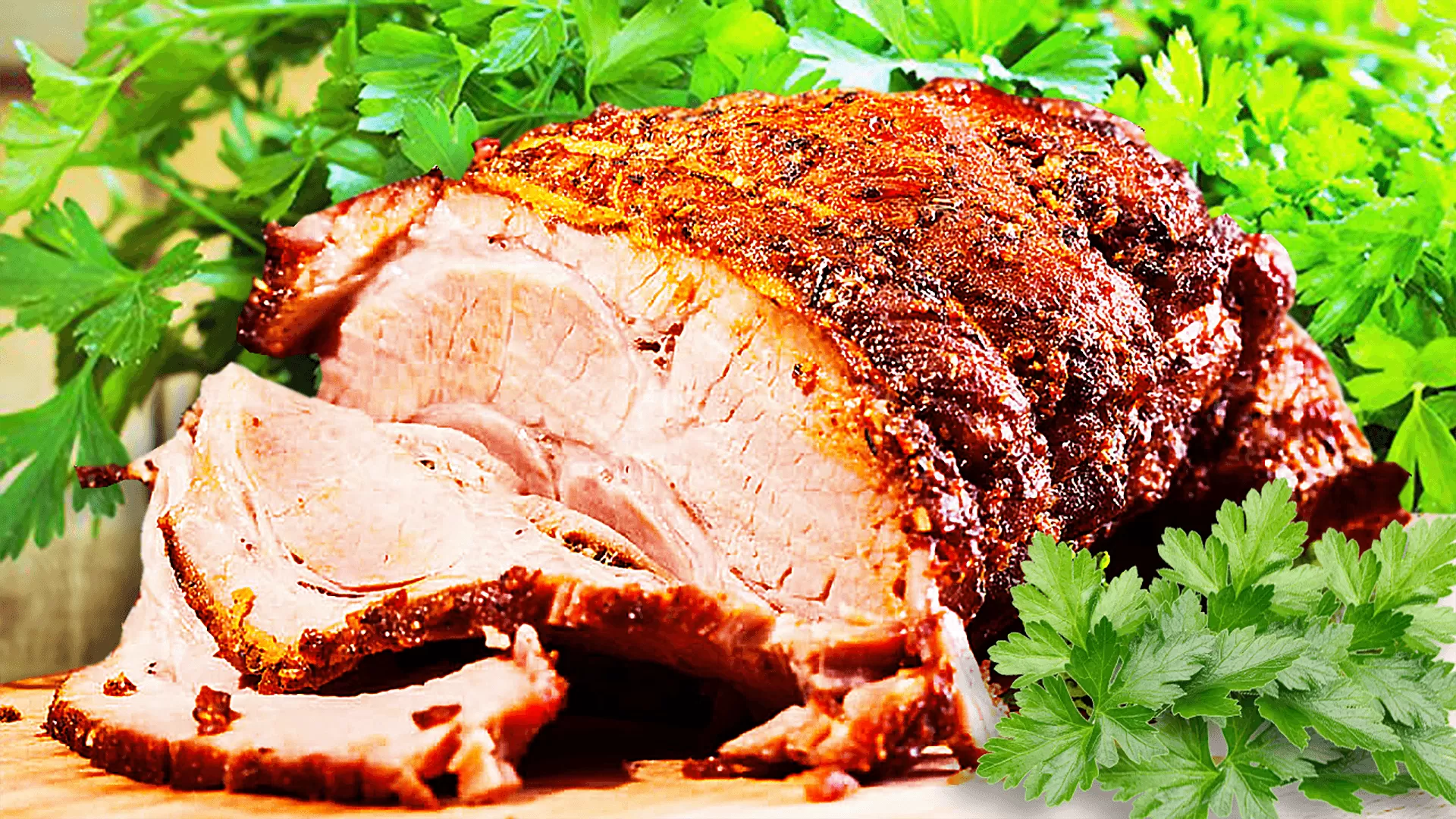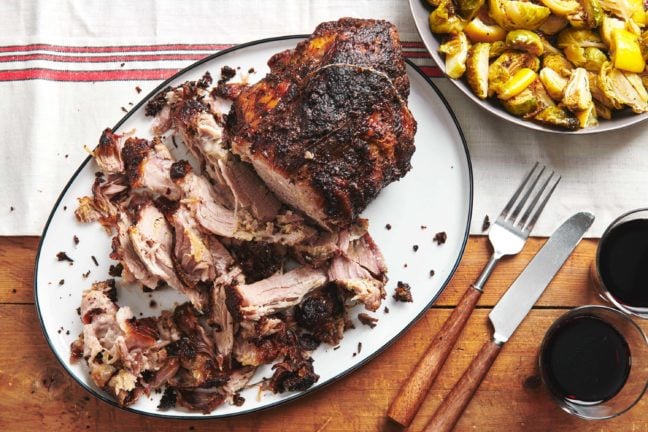A marinated pork shoulder or butt roast recipe that is slow-cooked and very tender. It tastes great on its own and can be used in a lot of different ways. One of my go-to dishes for casual crowd entertaining.
The boneless Boston butt pork roast, also known simply as a pork butt roast, is an incredibly flavorful, inexpensive, and versatile cut of pork. When cooked properly, this cut transforms into tender, succulent meat that makes for fantastic sandwiches, tacos, rice bowls, and more.
There is a lot of information in this book that will help you cook a boneless Boston butt roast every time.
What is a Boston Butt Roast?
The Boston butt roast comes from the upper part of the front leg/shoulder of the pig. It’s a well-marbled cut that contains a good amount of connective tissue. The name comes from its resemblance to barrels, also called “butts” that were very popular in Boston in pre-Revolutionary War times.
When cooked low and slow, the connective tissue breaks down into gelatin, making the meat very juicy and tender. This cut is great for roasting, slow cooking, smoking, or grilling. The marbling provides great flavor.
Choosing the Right Roast
When selecting a boneless Boston butt roast, look for one that:
- Weighs 3-5 lbs to feed 4+ people
- Has good marbling throughout for flavor and moisture
- Has some external fat cap to baste the meat while cooking
- Is cut from the upper shoulder area
- Appears pinkish-red in color indicating freshness
The roast may also be labeled as a pork shoulder roast or pork butt roast at the store. Avoid cuts with discoloration or unpleasant odors.
Prepare the Roast
Rinse the pork roast under cold water and pat it completely dry with paper towels. Then, use a sharp knife to lightly score the fat cap in a crisscross pattern, about 1⁄4 inch deep This helps the seasoning penetrate and fat render.
Next generously season all sides of the roast with salt pepper, and spices like garlic powder, onion powder, smoked paprika, oregano, etc. Massage the seasoning into the meat.
For extra flavor, coat the roast in a quick marinade like olive oil, citrus juice, garlic, and herbs for 1-2 hours before cooking.
How to Cook a Boston Butt Roast
In the Oven:
The oven allows you to ‘set it and forget it’ for hands-off roasting.
- Preheat oven to 300°F.
- Place seasoned roast fat-side up on a wire rack in a roasting pan.
- Cook for approx. 1 hour per lb until internal temp reaches 195-205°F.
- Rest 15 mins before slicing.
On the Grill:
Get delicious smoky flavor by grilling over indirect heat.
- Prepare a two-zone fire, with higher heat on one side.
- Sear roast over direct heat, then move to indirect heat, fat-side up.
- Grill with lid closed, flipping occasionally, until 195-205°F internal temp.
In the Slow Cooker:
Let the slow cooker do the work for you.
- Season roast and place in a 6-qt slow cooker.
- Add 1 cup chicken/beef broth.
- Cook on low heat for 8-10 hours.
- Shred meat and serve.
In the Instant Pot:
Speed up cook time with the pressure cooker.
- Sear all sides of seasoned roast in pot on sauté mode.
- Add 1 cup broth, seal lid, and manual pressure cook on high for 55 mins per lb.
- Let pressure release naturally 10 mins before opening.
In the Smoker:
For ultimate flavor, slowly smoke the pork butt.
- Prepare smoker with wood chips to 225-250°F.
- Smoke roast 4-8 hours until internal temp hits 195-205°F.
- Let rest 30 mins before pulling meat.
Tell When the Roast is Done
The key is cooking the pork butt until it reaches an internal temperature of 195-205°F on a meat thermometer. At this temp, the connective tissue has melted into succulent gelatin and the meat pulls apart easily.
If undercooked, it will be tough. If overcooked, it dries out. Use a thermometer for perfect doneness every time.
Let It Rest
Once cooked, resist slicing into the roast right away. Instead, tent it loosely with foil and let rest for 15-30 minutes. This allows the juices to reabsorb back into the meat.
As it rests, make an easy sauce from the pan drippings like a maple bourbon sauce or apple cider gravy to serve with the pork.
Shred and Serve
After resting, use forks to shred and pull the boneless Boston butt into pieces or slices. It will shred easily if adequately cooked.
Serve the juicy, fork-tender pork in sandwiches, tacos, rice bowls, pasta dishes, or on its own with classic BBQ sides. Refrigerate leftovers up to 4 days.
Tips for the Best Roast
- Generously season the pork butt at least 30-60 mins before cooking.
- Add liquid like broth or apple juice/cider to the roasting pan.
- Baste the roast every hour for added moisture and flavor.
- Check temp after 4 hours, then every 30 mins until done.
- Let rest to allow juices to reabsorb before shredding.
- Slice across the grain for most tender texture.
Common Mistakes
Avoid these pitfalls when cooking your boneless Boston butt roast:
- Not using a meat thermometer to check doneness.
- Failing to let the roast rest before slicing.
- Overcooking the pork, drying it out.
- Undercooking the pork, leaving it tough.
- Forgetting to add liquid to the roasting pan.
- Not seasoning boldly enough.
FAQs
What’s the difference between a pork butt and pork shoulder?
The terms refer to the same cut – the upper part of the front leg/shoulder. Pork butt is just a nickname for Boston butt roast.
Can you cook a boneless pork butt roast from frozen?
Yes, just add 50% more cooking time if starting from fully frozen. Thaw in the fridge 1-2 days for best results.
What happens if you overcook Boston butt roast?
It dries out and becomes tough. Use a meat thermometer to prevent overcooking.
How long does cooked Boston butt roast last?
About 4 days tightly wrapped in the fridge. Freeze for 2-3 months in an airtight bag for longer storage.
What’s the ideal internal temperature for pork butt?
195-205°F is ideal to melt connective tissue and make the meat pull apart easily.
In Summary
The Boston butt is an inexpensive, flavorful cut that when cooked properly results in incredibly juicy, tender shredded pork. Allow ample time for low, slow cooking until the internal temp hits 195°F. Rest, then shred and enjoy!

Fat Side Down or Up?
You can use bone-in pork shoulder instead of boneless pork shoulder because it will cook in about the same amount of time. Some cook faster than others. The directions say to put the fat side down in the pan so that the top can get a nice crust, but it doesn’t really matter. There is less crusty top when there is fat on top, which kind of bastes the pork as it cooks. Your call, you won’t go wrong.
The best part is that you have time to read, dance, sleep, clean your closet, or save kittens from trees.

Slow Cooking Pork in Oven
You can slow cook pork shoulder in the oven with or without bones, which gives you a lot of options, which is great when you’re having people over. At this low temperature, the roast would still be fine after an extra hour or two of cooking. So you can literally plunk it on the table whenever everyone is ready to eat.
